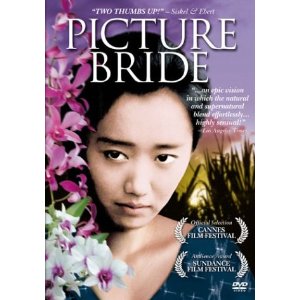 By Jae-Ha Kim
By Jae-Ha Kim
Chicago Sun-Times
May 21, 1995
At the beginning of “Picture Bride,” a 16-year-old girl living in Tokyo is shown a picture of a handsome Japanese man who has immigrated to Hawaii. Along with the photograph, he has sent a beautiful, poetic letter that doesn’t win her heart so much as it promises her a better life than what she has now. She sends back her picture, and the two agree to marry.
The man she meets on her wedding day is not the young man from the photographs, but a man 20 years older. He apologizes for deceiving her with an old photo, but both know she would not have agreed to marry him if he had sent a current picture.
A sweet, lush film set on a Hawaiian sugar cane plantation during the early 1900s, “Picture “Bride” (which is in an exclusive Chicago area engagement at the Pipers Alley) is director-writer Kayo Hatta’s foray into big-time filmmaking. The movie, which was shown at the 1994 Cannes Film Festival, won the audience award for best dramatic film at this year’s Sundance Festival.
“I was really surprised at how well it did (at Sundance), though by the time we got (to the festival) there was a buzz building about the film,” Hatta said, sitting in a suite at the Ritz-Carlton Hotel. “When we showed the film at Cannes, it was a different cut, and I wasn’t as happy with it. The (re-edited version) we showed at Sundance is what will run in theaters, and although I liked it very much, I had some doubt whether people would enjoy it – whether it would be perceived as being an `Asian’ film. But it got a really good response. And people related to the movie.”
Born Lori Kayo Hatta in Hawaii, the Japanese-American filmmaker grew up in New York. After graduating from Stanford University – where she had flip-flopped her first and middle names – Hatta earned her master of fine arts degree in film production from the University of California at Los Angeles. “Picture Bride” started out as a 30-minute thesis at UCLA, but she decided the story was too important to be told in half an hour.
Though Hatta’s film is a fictional account of the 20,000 Japanese and Korean women who became “picture brides” in the early 1900s, the central character, Riyo, is based on Hatta’s maternal grandmother. Her grandmother wasn’t a picture bride – in fact, she was proud of telling her grandchildren that she married for love – but she resembled Riyo in many ways, Hatta said. Both were pretty, city girls whose frail bodies belied their determination and strength.
The stereotype of arranged Asian marriages is still prevalent today, and Hatta said she wanted to stay away from images of subservient women keeping their men happy.
“Too often Asian women are portrayed as geishas or some other exotic types,” Hatta said. “I wanted to get away from that, but to not be overly reverential about women, either. I wanted to show them as real human beings who had fears and dreams, sexual desires. . . . I wanted to show they they could be devoted to their families but also harbor wishes of escaping their hardships. I wanted them to be real.”
Hatta selected Japanese film and singing star Youki Kudoh to star as Riyo. Best known to American audiences for her role as a hip, Japanese teen in search of Graceland in Jim Jarmusch’s “Mystery Train” (1990), the 23-year-old actress ended up getting married to one of the extras she met on the set. Tamlyn Tomita (“The Joy Luck Club,” “The Karate Kid Part II,”) plays her best friend Kana.
“Even though viewers recognize Tamlyn’s name and face (more than Kudoh’s), I knew that a Japanese-American wouldn’t have the same authenticity playing a Japanese woman as an actress who was born and raised in Japan,” Hatta said. “They move differently, speak differently and act differently. When I made the film, getting a `name’ actress wasn’t really a consideration. We had a small budget, and everyone who did the film really did it as a labor of love to get a story told that in many ways related to their lives.”
Raising the $1 million budget needed to make “Picture Bride” proved to be more difficult than getting the actors. Hatta raised half the money through grants from organizations such as the National Endowment for the Humanities. Kudoh’s involvement helped get hundreds of thousands of dollars from Japanese companies.
As anxious as Hatta was to get this film made, she also was determined to work with other Asian-American women in telling this story. She wrote the film with her sister, Mari. The Hattas then teamed up with producers Diane Mei Lin Mark and Lisa Onodera, one of Kayo Hatta’s classmates at UCLA.
Asked whether she ever thought a film about Asian characters would be commercially successful in America, Hatta said, “Not when I was growing up. But in the late ’80s and early ’90s, I saw that they could be. And after `The Joy Luck Club,’ which had just finished shooting around the time I was shooting `Picture Bride,’ came out, I knew that a good story would find an audience.
“Someone once said to me that a white audience wouldn’t accept a story from an ethnic point of view. And my theory is that you can’t tell a universal story without getting specific. I know that sounds ironic. But I think people connect to the characters, and not what color the characters are.”